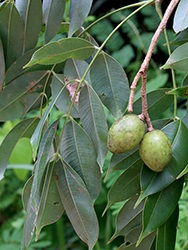e-Flora of Thailand
Volume 10 > Part 3 > Year 2010 > Page 325 > Anacardiaceae > Spondias
5. Spondias pinnata (L.f) Kurzwfo-0001049363
Rep. Pegu. App. A. 44 & B. 42. 1875; Merr., Int. Rumph.: 332. 1917; En. Philipp. 2: 470. 1923; Craib, Fl. Siam. Enum. 1: 356. 1926; Burkill, Dict. 2: 2067. 1935; Corner, Ways. Trees. 1: 116. 1940; Tardieu, Fl. Cambodge, Laos & Vietnam 2: 133. Pl. 8. f. 1–7. 1962; Backer & Bakh.f., Fl. Java 2: 151. 1965; Airy Shaw & Forman, Kew Bull. 21: 8. f. 2(1&2). 1967; Ding Hou in Fl. Males. ser. 1, 8: 483. 1978; Meijer in Dassanayake & Fosberg, Fl. Ceylon. 4: 23. 1983; Chayamarit, Thai Forest Bull. (Bot.) 22: 20. 1994; T.Ming & A.Barfod in W.Zhengyi, P.H.Raven & H.Deyuan, Fl. China 11: 339. 2008. Fig. 19.
Accepted Name : This is currently accepted.
Synonyms & Citations :
Description : Tree, 5–25 m, deciduous; all parts glabrous; bark grey, smooth. Leaves: petioles 5–25 cm long; leaflets 4–6 pairs, oblong or elliptic, 4–26 by 1.7–10.5 cm, apex acute or abruptly acuminate, base obliquely rounded or obtuse, entire or crenulate, subcoriaceous; lateral nerves 10–24 per side, almost parallel, joined by a strong intramarginal vein; petiolules 2–7 mm. Inflorescences in terminal, stout glabrous panicles. Flowers white, small, subsessile; calyx lobes triangular, ca 1 mm long; petals imbricate, ovate-oblong, 2–3 by 1–1.5 mm; filaments 1.5 mm long, subulate, anthers yellow, ovoid, ca 0.5 mm long; disc broad, crenulate, yellow; ovary ovoid, ca 1 mm; styles 5, stout. Drupes ellipsoid to oblong-ovoid, 3.5–4.5 by 2.5–3.5 cm, dark greenish-yellow, edible; pulp soft, sour with bitter taste; endocarp without radiating spinose processes, but with dense smooth peripheral zone of longitudinally arranged fibres, and interspersed with little parenchymatous tissue. Seeds usually 1, scars of style 5, lateral at the apical.
Thailand : NORTHERN: Chiang Mai, Chiang Rai (Chiang Saen), Mae Hong Son (Mae Surin), Nakhon Sawan (Takhli); NORTH-EASTERN: Loei (Phu Kradueng); EASTERN: Nakhon Ratchasima (Sakaerat); SOUTH-WESTERN: Ratchaburi (Ban Pong); PENINSULAR: Surat Thani (Ko Tao), Nakhon Si Thammarat (Thung Song, Chawang), Trang (Khao Chong), Satun (Ko Adang).
Distribution : India (type), Ceylon, Myanmar, Andaman Islands, China (Hainan), Cambodia, Vietnam, Peninsular Malaysia, Java, Celebes, Molucca, the Philippines.
Ecology : Common in mixed deciduous and evergreen forests, 50–500 m alt. Widely cultivated.
Vernacular : Kok kuk (กอกกุก), kuk (กูก)(Chiang Rai); kok-mong (กอกหมอง)(Shan Northern); kuk (กุก)(Chiang Mai); makok pa (มะกอกป่า)(Nakhon Ratchasima); phai-sae (ไพแซ)(Karen-Chiang Mai); kra-pai (กราไพ้ย), phai (ไพ้ย)(Karen-Kanchanaburi); kok khao (กอกเขา)(Nakhon Si Thammarat); ma kok (มะกอก)(Central).


